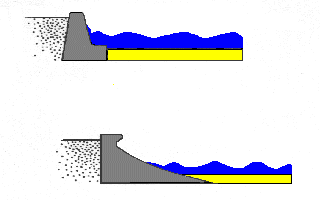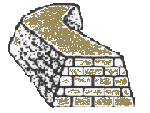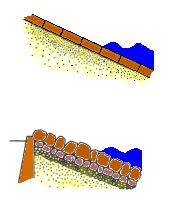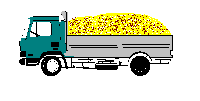|
The traditional 'hard' defence is the sea wall. In the past sea walls were vertical and deflected the energy of the waves away from the coast. In doing so, however, they suffered a lot of expensive damage in a short period of time. Modern sea walls have a slope and curved top which breaks up the energy of the wave and prevents water going over the top of the wall during heavy storms. Sea walls are very expensive (£2000-£5000 per metre) but should last 20-30 years. |
|
|
|
A breakwater is often used to protect a harbour but may be used to protect a stretch of coastline. They are usually made of concrete or blocks of stone but recent cheaper alternative suggestions have included oil drums and used tyres. They have to be strong enough to take the full force of the waves. Since they have to be built in deep water they are, like sea walls, expensive to build. |
|
|
|
The best form of natural defence is a beach which efficiently absorbs the energy of the waves. Along many coasts, however, longshore drift causes the beach to thin out in places and erosion of the land behind becomes a problem. Groynes are designed to slow down longshore drift and build up the beach. They are usually made of tropical hardwoods which are more resistant to marine borers and erosion. A few are made of concrete, steel or in more recent times large rocks. They are built at right angles to the shore and spaced about 50-100 metres apart. Groynes may have a life of 15-20 years but often have to be replaced rather than repaired. |
|
|
|
A cheaper alternative to sea walls is the revetment (about £1200 per metre). This is a sloping feature which breaks up or absorbs the energy of the waves but may let water and sediment pass through. The older wooden revetment consists of posts fixed into the beach with wooden slats between. Modern revetments have concrete or shaped blocks of stone laid on top of a layer of finer material. Rock armour or riprap consists of layers of very hard rock with the largest, often weighing several tonnes, on the top. Riprap has the advantage of good permeability plus it looks more natural. |
|
|
|
The gabion is a metal cage filled with rocks, about 1 metre by 1 metre square. They are stacked to form a simple wall. They are used to protect a cliff or area in the short term only, since they are easily damaged by powerful storm waves and the cages tend to rust quite quickly. Gabions have the advantage of ease of use and are relatively cheap but their life span is short. |
|
|
|
Where longshore drift is a serious problem and the supply of beach material is poor, it may be necessary to supplement the natural system by adding lorry loads of sand and shingle to the beach. The natural processes will then spread the material along the coast to help build up the natural defences. This is called beach nourishment. Sometimes dredgers may be anchored offshore and the sediment sprayed on to the beach using high pressure hoses. |
1809
After thousands of years of natural retreat, the first attempt at coastal management was in 1809 when Trinity House protected the base of the Twin Towers of St. Mary's Church with wooden and then ragstone blocks. The 'apron' of rocks protected the Towers, which started life about 3kms from the sea but were by this time right next to the sea, from further erosion. A few wooden groynes were later added to the beaches on either side of the Towers to retain the shingle beach.
1950s
Following the disastrous floods of 1953, which left many parts of North Kent under 2 metres of seawater, a great deal of engineering activity took place. The aim was to build 'hard defences' to reduce the risk of further floods and damage. A concrete sea wall stretching for 4.5 kms (about 3 miles) was built from Reculver to Minnis Bay near Margate.. This protected the low-lying farmland adjacent to the Isle of Thanet and also the Ramsgate to London railway. A much smaller concrete sea wall west of the Twin Towers was built to prevent flooding at Reculver. This had a curved upper section to break up the energy of the waves. More wooden and some metal groynes were placed on the beaches to slow down longshore drift.
1960s
At Bishopstone Glen, the soft clay and sandstone cliffs were so unstable that the houses at the top were under threat of destruction. So a sea wall was built beneath the cliffs and a further line of wooden groynes built to protect the sea wall by retaining more of the shingle beach. On the top of the cliff, the clay layer was graded (given a gentler slope) to stop it slipping and drains put in to take away excess water. Grass was planted so that the roots held the surface together. A monitoring system was also installed to detect movements in the cliff.
1980s
In the 1980s it was decided to extend the defences at Bishopstone Glen but because the eastern side was part of a protected S.S.S.I. (Site of Special Scientific Interest), a less harsh approach was needed. Instead of extending the concrete sea wall, a layer of huge boulders or rip rap, was built up to absorb the energy of the waves. The cliff top was again graded and grassed over to prevent further slumps in the clay layer.
1990s
By 1995 a large number of sea defences were showing their age and the Environment Agency and Canterbury City Council spent some £4.5 million upgrading the coastal defences at Reculver. Prior to this, there had already been the need to start a beach nourishment scheme whereby shingle was brought in by lorry and dumped on the beach each winter. To the west of the Twin Towers, 14 rock groynes were built using large blocks of hard, mainly igneous, rock. In between the rock groynes, half a million tonnes of shingle were sprayed on to the beach from a dredger anchored offshore. Together, the rock groynes and the extra shingle were expected to protect the sea wall from further erosion and undermining by winter storms.
In 1999, further work was carried out at Reculver to strengthen even further the defences. The concrete sea walls were repaired. The last of the old wooden and metal groynes were removed and thousands of tonnes of massive boulders were placed in front of the western and eastern sea walls. Some of the individual boulders weighed up to 10 tonnes each! Beach nourishment continues each winter to replace the material lost by longshore drift.
The Future ?
We now know that the problem of coastal management is getting more complicated. Some people believe that we should not build any more 'hard' defences and that the environment should be left alone as much as possible - such a policy of 'managed retreat' would result in a lot more land being lost to the sea with dunes and marshland eventually forming a natural barrier. As if all that wasn't enough, sea level is rising in Kent at about 6mm per year (0.6 metre in 100 years). Floods are, therefore, much more likely in future years whatever we do along this coast. The Isle of Thanet may yet become an island again...
















